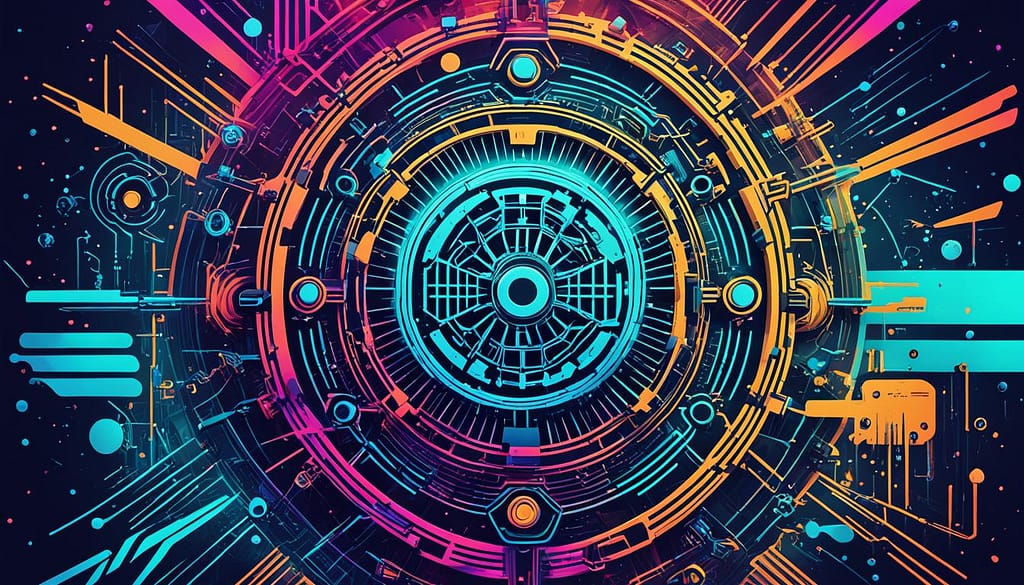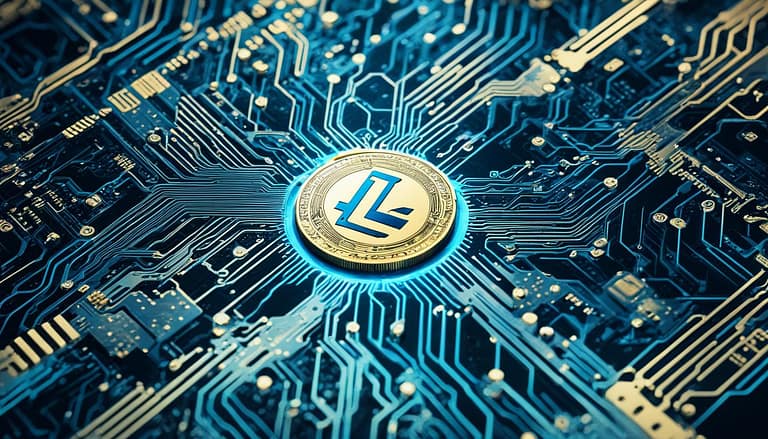What is Cardano?
In the burgeoning realm of digital currency, the Cardano blockchain stands out as a beacon of innovation and sustainability. Born from the intellectual rigor of Charles Hoskinson, a co-founder of Ethereum, Cardano offers an alternative to the conventional proof of work (PoW) models with its proof of stake (PoS) protocol. This forward-thinking platform functions not only as a transactional currency but also as a fertile ground for smart contracts and decentralized applications.
Imbued with the name of the Italian mathematician Gerolamo Cardano, and its cryptocurrency Ada paying tribute to the pioneering computer programmer Augusta Ada King, Cardano is underpinned by principles of scientific philosophy and peer-reviewed academic research. In its quest to democratize finance, Cardano is structured to provide accessible financial services to those previously excluded from the banking system, boasting a notable market capitalization and standing as a formidable presence in the global digital economy.
Since its inception, Cardano’s evolutionary path has seen continuous improvement, aiming to create a more equitable and transparent digital financial landscape. With each iteration and update, its robust architecture invites a broader range of use cases, ensuring its position as a highly respected player in the blockchain domain.
Key Takeaways
- Cardano is a pioneering PoS blockchain developed by Ethereum co-founder Charles Hoskinson.
- Its native digital currency, Ada, foregrounds energy efficiency and scalability in the cryptocurrency landscape.
- The platform is tailored for fostering secure smart contracts and flourishing decentralized applications (dApps).
- Cardano is firmly situated in aiding the unbanked, with a visionary framework designed to bridge economic disparities.
- With a reputation for continuous refinement, Cardano consistently strengthens its influence in the digital currency ecosystem.
An In-Depth Introduction to Cardano
Embarking on a transformative journey in the digital currency sphere, Cardano emerged as a pioneering force with its innovative vision of a decentralized future. At the core of its mission is the fostering of a robust cryptocurrency ecosystem engineered to overcome the limitations of previous blockchain generations.
The Birth of Cardano and Its Cryptocurrency, Ada
Conceived by the co-founder of Ethereum, Charles Hoskinson, Cardano was established with an ambitious goal—to propel the blockchain infrastructure into a new era of technological maturity. It extends beyond the foundational aspects of Bitcoin and the programmability of Ethereum to carve out its niche as a third-generation blockchain. The introduction of its native currency, Ada, marks a cornerstone in its advancement, encapsulating both homage to the legacy of Ada Lovelace and a signal of cardinal innovation in the blockchain domain.
Cardano’s Third-Generation Blockchain Vision
Cardano’s unveiled vision encapsulates a platform that is scalable, secure, and interoperable—requisites for the burgeoning reality of a smart contract-enabled digital economy. By harnessing the Ouroboros proof of stake protocol, it casts aside the energy-intensive practices of mining, instead offering an eco-friendlier incentive mechanism through Adastaking. Cardano’s ecosystem is purpose-built for a copious array of decentralized applications (dApps), epitomizing a philosophy that champions multi-asset ledger capabilities and fortified smart contracts. This multi-faceted approach not only accentuates the breadth of Cardano’s utility but also informs the ongoing speculations and predictions surrounding the ADA price.
| Feature | Cardano’s Implementation | Comparative Blockchain Generations |
|---|---|---|
| Consensus Protocol | Ouroboros Proof of Stake | Bitcoin (PoW), Ethereum 1.0 (PoW) |
| Ecosystem Capability | Decentralized Applications and Smart Contracts | Limited (Bitcoin), Initial Implementation (Ethereum) |
| Environmental Impact | Energy-Efficient Staking Rewards | Energy-Intensive Mining |
| Scalability Solution | Layered Architecture | Constrained Scalability |
| Interoperability | Cross-Chain Transfers & Native Token Support | Isolated & Siloed Networks |
With the architecture constructed by an array of scholars and a discerning roadmap, Cardano is striding towards realizing a sophisticated blockchain environment. It’s an arena designed not merely for transactions but for the secure and seamless exchange of complex contractual information—a testament to the foresight of its creators and the exigencies of tomorrow’s technological demands.
The Evolution of Cardano
Tracing the trajectory of Cardano’s rise in the realm of digital currency reveals a blockchain development journey rich with innovation and commitment to decentralization. Each phase of growth within the Cardano ecosystem is carefully encapsulated within distinct eras, each representing a leap forward in its capabilities and functions. From the foundational Byron to the aspirational Voltaire, Cardano’s progression offers a vivid blueprint of a blockchain’s maturation.
From Concept to Reality: Cardano’s Development Journey
The ethos of Cardano melds the foresight of encryption pioneers and the dreams of digital economy architects to form a platform both sturdy and adaptable. The inception of Cardano as a concept, meticulously transitioning into a tangible and robust blockchain, is a testament to the fortitude of its creators and the community that surrounds it. As the platform’s technology evolved, so too did the real-world utility and sophistication of the projects and protocols it supports.
Cardano’s Era System – From Byron to Voltaire
Epochal developments within Cardano’s life-span are demarcated by the era system, denoting significant updates and functionalities. Here’s a reflective glance at the remarkable stages that characterize Cardano’s ambitious blockchain evolution:
- Byron – The foundational layer set the stage for what was to come, establishing the network with the basic functionality of Ada transactions.
- Shelley – A stride towards a more decentralized network, Shelley introduced proof of stake, paving the way for network participants to stake their Ada.
- Goguen – This era saw the introduction of smart contract functionality, broadening the horizon for developers aiming to leverage the blockchain for innovative applications.
- Basho – Currently, the focus is on optimizing scalability and interoperability, critical components for supporting a broader ecosystem of applications.
- Voltaire – The forthcoming era promises robust governance features and a treasury system, ultimately leading to true decentralization and self-sustainability.
Each era contributes unique elements to the Cardano tapestry, strengthening its resolve to be a fully decentralized and community-driven platform where digital currency and smart contracts coalesce for universal utility.
| Era | Feature Highlights | Impact on Blockchain Development |
|---|---|---|
| Byron | Establishment of Cardano network’s underlying infrastructure | Laid the groundwork for subsequent developments and community engagement |
| Shelley | PoS implementation, increased network decentralization | Enhanced network security and participation by Ada holders |
| Goguen | Smart contract platform launch | Expanding Cardano’s utility beyond transactions to complex dApps creation |
| Basho | Focused on improving scalability and interoperability | Preparing the network for higher volume applications and transactions |
| Voltaire | Introduction of on-chain governance and treasury system | Moving towards a self-sustaining and community-led network |
Marked by rigorous planning and community consensus, Cardano’s milestones exhibit not just typical blockchain development; they demonstrate a commitment to creating a resilient digital currency ecosystem that anticipates the future needs of its users.
The Cardano Ecosystem
At the heart of the evolving world of blockchain technology, the Cardano ecosystem stands as a hallmark of innovation and sophistication. It is the fertile ground for a burgeoning array of decentralized applications (dApps), each leveraging the platform’s robust features to revolutionize the notion of digital currency. These dApps are inherent in Cardano’s infrastructure, designed to interoperate seamlessly, embodying the promise of a decentralized and transformative future.
Understanding Cardano’s Decentralized Applications (dApps)
Cardano’s approach to dApps extends beyond conventional expectations by fostering an environment conducive to secure and scalable applications. Through the implementation of smart contracts, developers find a receptive platform where their innovations can take flight. This approach culminates in not just a currency but a rich Cardano ecosystem, ingrained with flexibility and a community-driven spirit.
- Scalability and Functionality: Following the Alonzo update, the scalability of Cardano’s blockchain has been greatly enhanced, inviting a diverse range of application designs and functionalities.
- Security and Compatibility: Every dApp within the Cardano ecosystem benefits from the platform’s unwavering commitment to security, matched with the interoperability that allows dApps to function congruently.
- Innovation and Adaptation: Creators are continuously adapting to the ever-evolving landscape of digital currencies, with Cardano providing the necessary tools and environment for constant innovation.
Exploring the Cardano Community and Partnerships
The reach of Cardano’s community is evident worldwide. From educational initiatives to environmental consciousness, the partnerships formed under the Cardano umbrella are testament to its capability and adaptability. These collaborations transcend traditional blockchain applications, leveraging Cardano’s transparency and traceability for real-world problem solving and improvement.
| Partnership | Focus Area | Impact |
|---|---|---|
| Education in Ethiopia | Blockchain-based IDs | Improving national education systems through secure, transparent records. |
| Veritree | Tree-planting accountability | Utilizing blockchain for verifiable, sustainable reforestation efforts. |
| DISH Network | Digital identity services | Deploying secure identity solutions in the telecommunications sector. |
| Rival | NFT distribution in esports | Facilitating the exchange and ownership of digital collectibles in gaming. |
The catalyst for these remarkable applications and partnerships, without doubt, revolves around the power of smart contracts and the dynamic, supportive network that is quintessential Cardano. As the platform looks to the future, so does the expansion and growth of its diverse and resilient ecosystem.
Cardano’s Revolutionary Proof of Stake Protocol
In a digital age where environmental sustainability has become paramount, the cryptocurrency industry is under scrutiny for its energy consumption. As a digital currency that harnesses the PoS protocol, Cardano introduces an innovative solution with its Ouroboros algorithm, leading the way towards a more environmentally conscious future in blockchain technology.
Ouroboros: How Cardano’s PoS Stands Out
Cardano and its Ouroboros protocol redefine the stakes of proof of stake technology. What sets it apart is not only its foundation in peer-reviewed research but also the advantages it brings to the table over traditional PoW systems.
Ouroboros is the first PoS protocol built on scientifically assessed security and designed to harmonize the priorities of scalability, security, and decentralization. Both energy-efficient and secure, Ouroboros represents a significant stride in the pursuit of establishing a balanced, sustainable digital currency.
The Environmental Impact of PoS vs PoW
Cardano’s choice to implement a proof of stake consensus mechanism over the conventional proof of work not only exemplifies an evolution in blockchain technology but reflects its commitment to reducing the environmental impact of digital currency mining.
| Comparison Parameter | Proof of Work (PoW) | Proof of Stake (PoS) |
|---|---|---|
| Energy Consumption | High energy consumption due to mining | Minimal energy use as mining is not required |
| Environmental Impact | Significant carbon footprint | Reduced carbon footprint, more eco-friendly |
| Scalability | Limited by resource-intensive mining | Improved scalability due to efficient validation process |
| Economic Access | High entry barriers for miners | Lowered barriers for participating in transaction validation |
| Security Model | Computationally expensive to maintain security | Stake-based security aligning incentives with network health |
Promising an energy-efficient alternative, Cardano’s Ouroboros eschews energy-guzzling mining activities, instead incentivizing currency holders to engage in the validation process by staking their Ada. This mechanism not only ensures the integrity of the transaction process but significantly reduces the energy required to maintain the blockchain, thereby fostering an ecosystem sensitive to the needs of our environment.
Introducing Smart Contracts on Cardano
The Alonzo update has been a pivotal moment for Cardano, introducing the much-anticipated smart contracts feature. This advancement has set the stage for a surge in decentralized app development on the blockchain platform, offering flexible and secure solutions for digital transactions. As Cardano continues to mature, the implementation of smart contracts is anticipated to propel the digital currency into new realms of blockchain services.
The Alonzo Update and Expansion of Cardano’s Capabilities
The Alonzo update represents a significant milestone within Cardano’s development timeline. It has effectively broadened the reach of the blockchain platform, enabling it to support a myriad of digital contracts and applications. One of the hallmark features of this update is the seamless integration of smart contracts into the decentralized landscape of Cardano, ensuring both developers and users experience a robust, secure, and user-friendly environment.
The Role of Smart Contracts Within Cardano’s Ecosystem
Smart contracts on Cardano spotlight the blockchain’s potential as a springboard for innovation. Developers now have a robust toolbox for crafting complex digital agreements, underpinned by the security and transparency that is synonymous with the Cardano ecosystem. These self-executing contracts are transforming the way we visualize transactions and agreements in a digital space, enhancing the operational efficiency while minimizing the need for intermediaries.
| Feature | Description | Benefit |
|---|---|---|
| Decentralization | Smart contracts operate on a peer-to-peer network. | Enhances security and reduces reliance on central authorities. |
| Transparency | Contract terms are visible to all parties involved. | Builds trust among users and facilitates auditability. |
| Security | Immutable and secure against unauthorized alterations. | Safeguards against fraud and malicious activities. |
| Efficiency | Automated execution without intermediaries speeds up processes. | Reduces costs and accelerates transaction settlement times. |
| Innovation | Enables complex dApps and novel use cases. | Drives growth within the Cardano ecosystem through new services. |
The Fuel Behind Cardano: The Ada Cryptocurrency
Within the innovative realm of digital currencies, Ada cryptocurrency represents the powerhouse of the Cardano blockchain. This digital currency is pivotal not only as a medium of exchange but also as the quintessential element that unlocks the myriad functionalities inherent within the network. Ada is utilized for a variety of purposes, including transaction fees and as the reward mechanism for network validators—a testament to its integral role in the blockchain’s economy.
Staking Ada is tantamount to placing one’s vote of confidence in the Cardano network’s security and overall stability. It empowers Ada holders with the ability to have a say in the governance of the blockchain and to actively participate in the network’s consensus. Importantly, the advent of staking on Cardano transcends traditional earning opportunities, as it offers revenue streams for participants who contribute to the maintenance of the blockchain.
Accessibility to Ada cryptocurrency is facilitated through a robust network of exchanges that ensure seamless integration for users across the globe. The process of acquiring Ada and engaging in staking is becoming increasingly streamlined, bolstering Cardano’s growing influence as a go-to for both new and veteran users within the digital currency landscape.
Exchanges play a pivotal role not just as facilitators of Ada’s liquidity but also as gateways to the broader Cardano ecosystem. When paired with the option of direct network participation, Ada serves as a spark for ongoing innovation and essential development work across the blockchain. This dual mechanism empowers individuals to both assist the network’s operation and simultaneously reap benefits via staking payouts. Below is a comprehensive table outlining some of the key attributes of Ada’s functionality:
| Attribute | Description | Impact on Cardano Ecosystem |
|---|---|---|
| Transaction Fees | Minimal fees for processing transactions | Facilitates an efficient and user-friendly network |
| Staking Rewards | Incentives received for participating in the network security | Encourages robust network activity and security |
| Network Governance | Ada holders can influence the direction of the network | Promotes a decentralized and democratic blockchain environment |
| Accessibility | Available on multiple exchanges globally | Ensures Ada can be easily bought, sold, and staked by anyone |
As Ada propels Cardano forward into the future, it fortifies its standing not merely as a digital currency, but as a testament to the possibilities of a secure, decentralized, and participatory financial ecosystem.
Staking and Earning with Cardano
The Cardano ecosystem presents a compelling avenue for Ada holders to engage in Cardano staking, enabling them to earn rewards and contribute to the stability and security of this digital currency. By joining staking pools, investors not only help maintain the decentralized nature of the network but also stand a chance to earn passive income through proof of stake.
The Mechanics of Cardano Staking
In the realm of Cardano, staking is more than merely holding Ada. It is an active participation process within the proof of stake system. When Ada holders delegate their coins to staking pools, they essentially entrust their stake to pool operators who maintain network integrity. Validators are then chosen to create new blocks and verify transactions based on the amount of stake contributed, without the need for energy-intensive mining.
Staking with Cardano represents a synergy of technology and community effort. It’s a decentralized ballet of numerous participants, each orchestrating the smooth operability of the blockchain. Here is a snapshot of how Ada holders can get involved with Cardano staking pools:
| Staking Option | Method | Benefits |
|---|---|---|
| Personal Staking | Individuals directly and personally stake their own Ada. | Full control over staking preferences with direct earnings. |
| Delegation to Public Pools | Ada holders delegate to available public staking pools within the network. | Passive income while contributing to the network’s decentralization. |
| Private Pools | Create or join private, exclusive staking pools often with association to specific communities. | Specific community goals and possible higher performance pools. |
Finding the Best Cardano Staking Pools
Finding the right staking pool to maximize earning rewards can be a meticulous task. One must consider factors like pool performance, fees, and reliability. Stake pool tools like ADApools.org offer a wealth of information, allowing for informed decisions. Utilizing wallets such as Yoroi, Exodus, and Daedalus can simplify the process of stake management, providing users with intuitive interfaces and secure environments to grow their digital currency holdings through Cardano’s staking ecosystem.
Real-world Applications of Cardano
As blockchain technology continues to revolutionize industries, Cardano emerges as a leading platform in linking digital innovation to practical, real-world use cases. Through key partnerships and initiatives, Cardano is demonstrating tangible impacts across various sectors, with particular emphases on education, environmental sustainability, and enhancing corporate efficacy through digital identity solutions.
Cardano’s Initiatives in Education and Reforestation
In a move towards bolstering the educational infrastructure, Cardano has partnered with the Ethiopian Ministry of Education to create blockchain-based digital identities for students. This initiative aims to streamline the management of educational records and offer a seamless and secure platform for academic credential verification. Moreover, Cardano’s commitment to the environment is evidenced through its collaboration with veritree, a project dedicated to reforestation. Using Cardano’s blockchain to immortalize the growth of trees, this project exemplifies how blockchain can play a pivotal role in ensuring the success and transparency of ecological conservation efforts.
Digital Identity and Cardano’s Corporate Collaborations
Expanding the reach of blockchain into the corporate sphere, Cardano’s collaboration with DISH Network pioneers the use of blockchain technology in telecommunications for digital identity services. This innovative application serves as a testament to how Cardano’s versatile ecosystem can be leveraged by enterprises to enhance security, efficiency, and trust in digital interactions.
Below is a summarized table that illustrates the scope and impact of Cardano’s real-world applications in education, environmental efforts, and corporate collaborations:
| Sector | Initiative | Partner | Impact |
|---|---|---|---|
| Education | Blockchain-based Digital IDs | Ethiopian Ministry of Education | Enhanced secure record-keeping and credential verification |
| Environment | Reforestation Transparency | veritree | Accountable and verifiable tree-planting initiatives |
| Corporate | Digital Identity Services | DISH Network | Improved digital identity security in telecommunications |
The strategic use of Cardano in these areas showcases its broad real-world applications and ratifies the versatility of blockchain technology. These ventures are setting the stage for widespread adoption, where the benefits of blockchain, such as digital identity, can be realized on a global scale.
How to Get Started with Cardano
Embarking on your journey with Cardano, an emerging leader in the world of cryptocurrency, begins with obtaining its native digital currency, Ada. As an innovative blockchain platform, Cardano offers a secure and decentralized environment for both novices and experienced users alike. Engaging with this ecosystem provides an opportunity to explore the comprehensive capabilities of a third-generation blockchain while investing in a digital currency poised for substantive growth.
Obtaining Cardano’s Ada: Exchanges and Direct Participation
To step into the Cardano realm, acquiring Ada is your initial task. It involves engaging with cryptocurrency exchanges — platforms that couple robust security features with user-friendly interfaces to streamline your purchase of Ada. For those who prefer a more hands-on approach, direct network participation presents an avenue to earn Ada. Both methods are foundational to being an active player within the Cardano community, where the possession and management of Ada open up a broad spectrum of functionalities and staking options.
Setting Up a Wallet and Staking Options
Selecting the right wallet to store, manage, and stake your Ada is essential. Not only does your choice contribute to the operational security of the Cardano network but it also determines the fluidity of your interactions within the ecosystem. Wallets such as Daedalus and Yoroi are popular in the community, designed to meet the needs of both straightforward transactions and the intricate processes of staking. By joining staking pools, you can harness the power of your Ada to not only stabilize but also partake in the fiscal evolution of Cardano’s network, facilitating a dynamic environment for digital currency growth and innovation.
FAQ
What is Cardano?
How was Cardano and its cryptocurrency Ada created?
What is Cardano’s vision as a third-generation blockchain?
How has Cardano evolved since its inception?
What applications does the Cardano ecosystem support?
How does Cardano’s proof of stake protocol work?
What impact did the Alonzo update have on Cardano?
What is Ada and what role does it play in Cardano?
How does staking on Cardano work and what are the benefits?
How does Cardano contribute to real-world challenges?
How can someone start using Cardano?
Source Links
- https://www.investopedia.com/cardano-definition-4683961
- https://cardano.org/what-is-ada/
- https://www.fool.com/terms/c/cardano/










